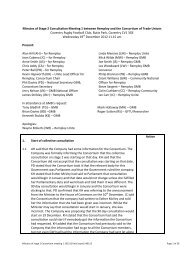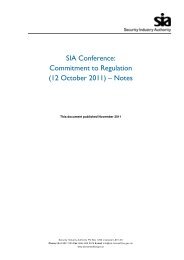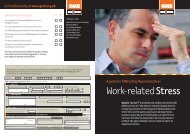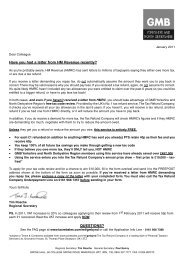Career Average Pensions - September 2010.pdf
Career Average Pensions - September 2010.pdf
Career Average Pensions - September 2010.pdf
You also want an ePaper? Increase the reach of your titles
YUMPU automatically turns print PDFs into web optimized ePapers that Google loves.
CARE SCHEMES Sep 2010<br />
Pension Guide<br />
www.gmb.org.uk/pensions<br />
CAREER AVERAGE PENSIONS<br />
INTRODUCTION<br />
This briefing looks at career average pension schemes and analyses the<br />
differences between these and the more common form of defined benefit<br />
arrangement: final salary schemes.<br />
<strong>Career</strong> average pensions, are also known as CARE schemes (<strong>Career</strong> <strong>Average</strong> of<br />
Revalued Earnings) are an alternative type of defined benefit pension scheme<br />
to the traditional final salary model. As variations on a theme, CARE schemes<br />
and final salary schemes operate in a very similar way, providing an annual<br />
pension which is calculated by reference to the following formula:<br />
Pension = AccrualRate × Service×<br />
Earnings<br />
The only difference that necessarily exists between comparative CARE and final<br />
salary schemes is the definition of earnings that is used in the above formula.<br />
Whilst a final salary scheme would use the amount of pensionable salary in the<br />
run up to retirement, a CARE scheme would look at the pensionable salary<br />
over a member’s whole period of service.<br />
Final salary schemes offer a more beneficial level of pension to members<br />
whose pay might be significantly increased in the run up to retirement. This<br />
means that members who do not receive such large pay rises are in effect<br />
cross-subsidising those members who do, as their contributions are<br />
proportionately higher (when compared with the level of pension paid out).<br />
REVALUED EARNINGS<br />
One of the most important features of CARE schemes is the method of<br />
revaluation of earnings. This is important as there may be a period of 40<br />
years or more between the first year’s pensionable salary and the retirement<br />
date. Over this period of time the real value of the early years' pensionable<br />
salary will have been decreased by the effects of price or wage inflation.<br />
To stop this decrease schemes will revalue (i.e. increase) each year’s<br />
pensionable salary in line with a certain index between the year in which the<br />
earnings were received and the date of retirement.<br />
- 1 -
The indexation may be in line with price changes as given by the Retail Prices<br />
Index (RPI) or Consumer Prices Index (CPI); or in line with the national<br />
average earnings (NAE) Index; alternatively it can be a fixed amount such as<br />
2.5%.<br />
An example of revalued earnings is shown below. It assumes that the index by<br />
which earnings are revalued is a consistent 2% per annum and the member is<br />
in the CARE pension scheme for 5 years immediately before retirement.<br />
Year<br />
Pensionable<br />
Earnings<br />
Revaluation<br />
Percentage *<br />
Revalued<br />
Pensionable<br />
Earnings<br />
1 £20,000 8.24% £21,649<br />
2 £20,500 6.12% £21,755<br />
3 £21,000 4.04% £21,848<br />
4 £22,000 2.00% £22,440<br />
5 £23,000 0.00% £23,000<br />
AVERAGE £21,300 £22,138<br />
* the revaluation percentage for the first year is 2% compound interest over 4 years<br />
The table shows that the average pensionable salary is £21,300, but the<br />
average revalued pensionable salary is significantly higher at £22,138.<br />
CAREER AVERAGE VERSUS FINAL SALARY<br />
In the example above we see average revalued earnings of £22,138. If this<br />
member was in a career average scheme with an accrual rate of 1/60, then<br />
this would result in a pension of:<br />
5<br />
× £22,138 = £1,845pa<br />
60<br />
The final salary in the example is £23,000. If the member was in a final salary<br />
scheme with an accrual rate of 1/60, the pension would be:<br />
5<br />
× £23,000 = £1,917 pa<br />
60<br />
So for this member, a final salary scheme with the same accrual rate would<br />
yield a better pension.<br />
However, to retain the same overall scheme value when a scheme is changed<br />
from final salary to CARE it is generally necessary to improve the accrual rate<br />
e.g. from 1/60 to 1/57, in this case the adjustment to the accrual rate in the<br />
CARE context would lead to a higher pension than in the final salary scheme:<br />
5<br />
× £22,138 = £1,942 pa<br />
57<br />
Two further examples of the pensions members who are on significantly<br />
different career paths might get from the same pension schemes are<br />
highlighted below. Andy receives regular promotions throughout his 8 year<br />
career, whereas Diane’s pay rises are gradual and reflect general pay rises.<br />
- 2 -
EXAMPLE 1<br />
Benefit<br />
This example assumes general pay rises are 2% per year on average whereas<br />
price inflation is 2.5%. Two different accrual rates are considered for the CARE<br />
schemes.<br />
Andy<br />
Diane<br />
Year Earnings Revalued Earnings Earnings Revalued Earnings<br />
1 £20,000 £23,774 £20,000 £23,774<br />
2 £20,400 £23,658 £20,400 £23,658<br />
3 £20,808 £23,542 £20,808 £23,542<br />
4 £25,000 £27,595 £21,224 £23,428<br />
5 £25,500 £27,461 £21,649 £23,313<br />
6 £36,000 £37,823 £22,082 £23,199<br />
7 £36,720 £37,638 £22,523 £23,086<br />
8 £48,000 £48,000 £22,974 £22,974<br />
<strong>Average</strong> £31,186 £23,372<br />
CARE Pension<br />
(1/54) £4,620 £3,462<br />
CARE Pension<br />
(1/60) £4,158 £3,116<br />
Final Salary Pension<br />
(1/60) £6,400 £3,063<br />
Contributions<br />
In a flat rate contribution scheme (e.g. where all members pay in 6.5%) Diane<br />
will have paid in about three quarters of the amount paid in by Andy over the 8<br />
years (£11,158 compared with £15,108 i.e. 74%) and would receive a career<br />
average pension equivalent to about three quarters of Andy’s. However, on<br />
the final salary basis, Diane would receive a pension worth less than half of<br />
Andy’s.<br />
In a scheme with variable contribution rates this distortion is limited but still<br />
exists. Using the LGPS rates to illustrate, Andy would have paid in £15,662<br />
over the 8 years while Diane would have paid in £11,158 (71% of Andy’s) yet<br />
in the current final salary arrangement she would receive a pension that is only<br />
48% of Andy’s.<br />
- 3 -
EXAMPLE 2<br />
This example assumes general pay rises are 3% per annum on average<br />
whereas price inflation is 2.5%. As above, two different CARE accrual rates are<br />
considered. The differences in contributions would be similar to Example 1.<br />
Andy<br />
Diane<br />
Year Earnings Revalued Earnings Earnings Revalued Earnings<br />
1 £20,000 £23,774 £20,000 £23,774<br />
2 £20,600 £23,890 £20,600 £23,890<br />
3 £21,218 £24,006 £21,218 £24,006<br />
4 £25,000 £27,595 £21,855 £24,123<br />
5 £25,750 £27,730 £22,510 £24,241<br />
6 £36,000 £37,823 £23,185 £24,359<br />
7 £37,080 £38,007 £23,881 £24,478<br />
8 £48,000 £48,000 £24,597 £24,597<br />
<strong>Average</strong> £31,353 £24,184<br />
CARE Pension<br />
(1/54) £4,645 £3,583<br />
CARE Pension<br />
(1/60) £4,180 £3,224<br />
Final Salary Pension<br />
(1/60) £6,400 £3,280<br />
The examples above show that there are instances when a career average<br />
pension can be more beneficial to members than a final salary pension with the<br />
same accrual rate.<br />
The examples also show that career average has the effect of reducing the<br />
pensions payable to Andy who benefited from a number of promotions<br />
throughout his career. This can be mitigated by an improved accrual rate<br />
which GMB would expect if a scheme was changing from final salary to CARE<br />
without reducing a scheme’s overall value.<br />
- 4 -
EXAMPLE 3 - CAREER AVERAGE PENSION FOR A MEMBER WHO GOES<br />
FROM FULL TIME WORKING TO PART TIME WORKING<br />
Just like in final salary schemes, the fairest way of treating part time service is<br />
to pro-rate a member’s pensionable service according to the difference<br />
between their part time hours and the full time equivalent number of hours<br />
and to calculate pensions by reference to the full time equivalent level of<br />
pensionable earnings. This is shown in the example below.<br />
The example assumes general pay rises are 2% per annum on average<br />
whereas price inflation is 2.5%. The member moves from working full time<br />
hours to reduced hours after four years – both part time and whole time<br />
equivalent (WTE) earnings are shown.<br />
Year<br />
Hours<br />
Pensionable<br />
Service<br />
(years)<br />
Actual<br />
Earnings<br />
WTE<br />
Earnings<br />
Revalued WTE<br />
Earnings<br />
1 37.5 1 £20,000 £20,000 £23,774<br />
2 37.5 1 £20,400 £20,400 £23,658<br />
3 37.5 1 £20,808 £20,808 £23,542<br />
4 37.5 1 £21,224 £21,224 £23,428<br />
5 22.5 0.6 £12,989 £21,649 £23,313<br />
6 22.5 0.6 £13,249 £22,082 £23,199<br />
7 15 0.4 £9,009 £22,523 £23,086<br />
8 15 0.4 £9,189 £22,974 £22,974<br />
Total Service 6 <strong>Average</strong> £23,372<br />
CARE Pension (1/54) [1/54 * 6 * 23372] £2,597<br />
CARE Pension (1/60) [1/60 * 6 * 23372] £2,337<br />
Final Salary Pension<br />
(1/60) [1/60 * 6 * 22974] £2,297<br />
EXAMPLE 4 - PENSION FOR A MEMBER WHOSE PAY IS REDUCED AT<br />
ONE POINT IN THEIR CAREER<br />
This section looks at someone whose pensionable pay is reduced at some point<br />
in their career meaning that their highest level of pay is not experienced in the<br />
run up to retirement and may not count towards their pension in a final salary<br />
scheme. Examples of such a scenario could be as the result of a job evaluation<br />
exercise or a member stopping pensionable overtime or shift work.<br />
The example below is similar to others used above in that it makes<br />
assumptions about price inflation and pay rises. In this example, price<br />
inflation is assumed to be 2.5% per annum. Pay is assumed to rise at a similar<br />
rate, except for the one off pay cut shown below after 7 years.<br />
- 5 -
Year Earnings Revalued Earnings<br />
1 £25,000 £39,966<br />
2 £25,625 £39,966<br />
3 £26,266 £39,966<br />
4 £26,922 £39,966<br />
5 £27,595 £39,966<br />
6 £28,285 £39,966<br />
7 £28,992 £39,966<br />
8 £21,500 £28,915<br />
9 £22,038 £28,915<br />
10 £22,588 £28,915<br />
11 £23,153 £28,915<br />
12 £23,732 £28,915<br />
13 £24,325 £28,915<br />
14 £24,933 £28,915<br />
15 £25,557 £28,915<br />
16 £26,196 £28,915<br />
17 £26,851 £28,915<br />
18 £27,522 £28,915<br />
19 £28,210 £28,915<br />
20 £28,915 £28,915<br />
Final Year's<br />
Earnings £28,915<br />
<strong>Average</strong><br />
Revalued<br />
Earnings £32,783<br />
CARE Pension (1/54) £12,142<br />
CARE Pension (1/60) £10,928<br />
Final Salary Pension<br />
(1/60) £9,638<br />
FACTORS THAT AFFECT THE CAREER AVERAGE PENSION<br />
As illustrated in the examples the main factor in designing a career average<br />
scheme, that will impact on the amounts of pensions paid, is the accrual rate.<br />
As with final salary schemes, a variety of accrual rates exist which are typically<br />
in the region of 1/40 to 1/100.<br />
The second feature is the rate at which earnings are revalued. The most<br />
common measure of revaluation is in line with price inflation, subject to an<br />
annual cap (e.g. 5%).<br />
Otherwise the level of pension you receive is dictated by how much you earn,<br />
how long you are in the pension scheme and at what age you take your<br />
pension – just like in a final salary scheme.<br />
GMB <strong>Pensions</strong> Dept<br />
22-4 Worple Road Wimbledon SW19 4DD<br />
Email: pensionsdeptwi@gmb.org.uk Tel: 020 8947 3131<br />
- 6 -
















